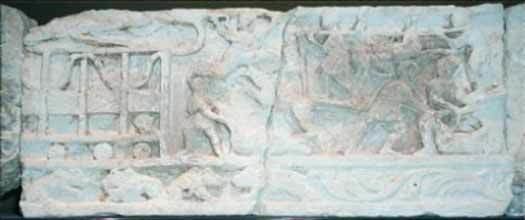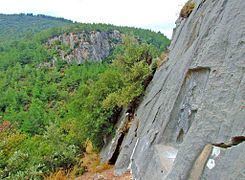 | ||
Arzawa
Arzawa in the second half of the 2nd millennium BC (roughly from late 15th century BC until the beginning of the 12th century BC) was the name of a region and a political entity (a "kingdom" or a federation of local powers) in Western Anatolia. The core of Arzawa is believed to have been located along the Kestros River (Küçük Menderes), with its capital at Apasa, later known as Ephesus. When the Hittites conquered Arzawa it was divided into three Hittite provinces: a southern province called Mira along the Maeander River, which would later become known as Caria; a northern province called the Seha River Land, along the Gediz River, which would later become known as Lydia; and an eastern province called Hapalla.
Contents
It was the successor state of the Assuwa league, which also included parts of western Anatolia, but was conquered by the Hittites in c. 1400 BC. Arzawa was the western neighbour and rival of the Middle and New Hittite Kingdoms. On the other hand, it was in close contact with the Ahhiyawa of the Hittite texts, which corresponds to the Achaeans of Mycenaean Greece. Moreover, Achaeans and Arzawa formed a coalition against the Hittites, in various periods.

Artsava the call of arzawa
The kingdom

According to Hittite sources, the capital of the Kingdom of Arzawa was Apasa (or Abasa), corresponding with later Greek Ephesus.

The languages spoken in Arzawa during the Bronze Age and early Iron Age cannot be directly determined due to the paucity of indigenous written sources. The current consensus among scholars is that the linguistic identity of Arzawa was predominantly Luwian, based, inter alia, on the replacement of the designation Luwiya with Arzawa in a corrupt passage of a New Hittite copy of the Laws, which appears to reflect a change in the name of the region. However, one scholar has recently argued that Luwiya and Arzawa were two separate entities, because Luwiya is mentioned in the Hittite Laws as a part of the Hittite Old Kingdom, whereas Arzawa was independent from the Hittites during this period. He also argued that there was no significant Luwian population in Arzawa, but instead that it was predominantly inhabited by speakers of Proto-Lydian and Proto-Carian.

The zenith of the kingdom was during the 15th and 14th centuries BC. The Hittites were then weakened, and Arzawa was an ally of Egypt. This alliance is recorded in the correspondence between the Arzawan ruler Tarhundaradu and the Pharaoh Amenophis III called the Arzawa letters, part of the archive of the Amarna letters (Nr.31 and 32), having played a substantial role in the decipherment of the Hittite language in which they were written.

According to Hittite records, in c. 1320 BC Arzawa joined an anti-Hittite alliance together with the region of Millawanta (Milet) under the king of Ahhijawa (the latter widely accepted as Mycenaean Greece or part of it). As a response of this initiative, the Hittite kings Suppiluliuma I and Mursili II finally managed to defeat Arzawa around 1300 BC. The king of Arzawa managed to escape to Mycenaean controlled territory. Arzawa was then split by the Hittites into vassal kingdoms. These were called;
"Seha river" is now believed to be the present-day Gediz River, although some scholars said it was the Bakırçay river.
Also, Mursili's son Muwatalli added Wilusa (Troy) as a vassal.
In 1998, J. David Hawkins succeeded in reading the Karabel relief inscription, located at the Karabel pass, about 20 km from Izmir. This has provided evidence that the kingdom of Mira was actually south of the 'Seha river land', thus locating the latter along the Gediz River.
These kingdoms, usually termed simply as "lands" in Hittite registers, could have formed part of the Arzawa complex already during the existence of Arzawa kingdom.
Known western Anatolian late-Bronze Age regions and/or political entities which, to date, have not been cited as having been part of the Arzawa complex are;
After the collapse of the Hittite Empire from the 12th century, while Neo-Hittite states partially pursued Hittite history in southern Anatolia and Syria, the chain seems to have broken as far as Arzawa lands in western Anatolia were concerned and these could have pursued their own cultural path until unification came with the emergence of Lydia as a state under the Mermnad dynasty in the 7th century BC.
There has been evidence from a British expedition in 1954 to Beycesultan in inner western Anatolia which suggests that the local king had central heating in his home. Nothing more was heard from this invention until Gaius Sergius Orata reinvented it in Ancient Rome around 80 BC.
